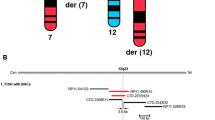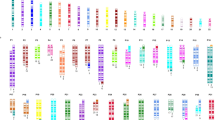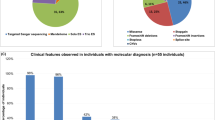Abstract
Duplications in the ~2 Mb desert region upstream of SOX9 at 17q24.3 may result in familial 46,XX disorders of sex development (DSD) without any effects on the XY background. A balanced translocation with its breakpoint falling within the same region has also been described in one XX DSD subject. We analyzed, by conventional and molecular cytogenetics, 19 novel SRY-negative unrelated 46,XX subjects both familial and sporadic, with isolated DSD. One of them had a de novo reciprocal t(11;17) translocation. Two cases carried partially overlapping 17q24.3 duplications ~500 kb upstream of SOX9, both inherited from their normal fathers. Breakpoints cloning showed that both duplications were in tandem, whereas the 17q in the reciprocal translocation was broken at ~800 kb upstream of SOX9, which is not only close to a previously described 46,XX DSD translocation, but also to translocations without any effects on the gonadal development. A further XX male, ascertained because of intellectual disability, carried a de novo cryptic duplication at Xq27.1, involving SOX3. CNVs involving SOX3 or its flanking regions have been reported in four XX DSD subjects. Collectively in our cohort of 19 novel cases of SRY-negative 46,XX DSD, the duplications upstream of SOX9 account for ~10.5% of the cases, and are responsible for the disease phenotype, even when inherited from a normal father. Translocations interrupting this region may also affect the gonadal development, possibly depending on the chromatin context of the recipient chromosome. SOX3 duplications may substitute SRY in some XX subjects.
Similar content being viewed by others
Log in or create a free account to read this content
Gain free access to this article, as well as selected content from this journal and more on nature.com
or
References
Berta P, Hawkins JR, Sinclair AH et al: Genetic evidence equating SRY and the testis-determining factor. Nature 1990; 348: 448–450.
Jobling MA : A selective difference between human Y-chromosomal DNA haplotypes. Curr Biol 1998; 8: 4.
Rosser ZH, Balaresque P, Jobling MA : Gene conversion between the X chromosome and the male-specific region of the Y chromosome at a translocation hotspot. Am J Hum Genet 2009; 85: 130–134.
Benko S, Gordon CT, Mallet D et al: Disruption of a long distance regulatory region upstream of SOX9 in isolated disorders of sex development. J Med Genet 2011; 48: 825–830.
Cox JJ, Willatt L, Homfray T, Woods CG : A SOX9 duplication and familial 46,XX developmental testicular disorder. N Engl J Med 2011; 364: 91–93.
Vetro A, Ciccone R, Giorda R et al: XX males SRY negative: a confirmed cause of infertility. J Med Genet 2011; 48: 710–712.
Xiao B, Ji X, Xing Y, Chen YW, Tao J : A rare case of 46, XX SRY-negative male with approximately 74-kb duplication in a region upstream of SOX9. Eur J Med Genet 2013; 56: 695–698.
Sekido R, Lovell-Badge R : Sex determination involves synergistic action of SRY and SF1 on a specific Sox9 enhancer. Nature 2008; 453: 930–934.
Vidal VP, Chaboissier MC, de Rooij DG, Schedl A : Sox9 induces testis development in XX transgenic mice. Nat Genet 2001; 28: 216–217.
Huang B, Wang S, Ning Y, Lamb AN, Bartley J, Autosomal XX : sex reversal caused by duplication of SOX9. Am J Med Genet 1999; 87: 349–353.
Benko S, Fantes JA, Amiel J et al: Highly conserved non-coding elements on either side of SOX9 associated with Pierre Robin sequence. Nat Genet 2009; 41: 359–364.
White S, Ohnesorg T, Notini A et al: Copy number variation in patients with disorders of sex development due to 46,XY gonadal dysgenesis. PLoS One 2011; 6: e17793.
Sanchez-Castro M, Gordon CT, Petit F et al: Congenital Heart Defects in Patients with Deletions Upstream of SOX9. Hum Mutat 2013; 34: 1628–1631.
Kurth I, Klopocki E, Stricker S et al: Duplications of noncoding elements 5' of SOX9 are associated with brachydactyly-anonychia. Nat Genet 2009; 41: 862–863.
Refai O, Friedman A, Terry L et al: De novo 12;17 translocation upstream of SOX9 resulting in 46,XX testicular disorder of sex development. Am J Med Genet A 2010; 152A: 422–426.
Sutton E, Hughes J, White S et al: Identification of SOX3 as an XX male sex reversal gene in mice and humans. J Clin Invest 2011; 121: 328–341.
Moalem S, Babul-Hirji R, Stavropolous DJ et al: XX male sex reversal with genital abnormalities associated with a de novo SOX3 gene duplication. Am J Med Genet A 2012; 158A: 1759–1764.
Spielmann M, Klopocki E : CNVs of noncoding cis-regulatory elements in human disease. Curr Opin Genet Dev 2013; 23: 249–256.
Bonaglia MC, Giorda R, Beri S et al: Molecular mechanisms generating and stabilizing terminal 22q13 deletions in 44 subjects with Phelan/McDermid syndrome. PLoS Genet 2011; 7: e1002173.
Allen RC, Zoghbi HY, Moseley AB, Rosenblatt HM, Belmont JW : Methylation of HpaII and HhaI sites near the polymorphic CAG repeat in the human androgen-receptor gene correlates with X chromosome inactivation. Am J Hum Genet 1992; 51: 1229–1239.
Rossi E, Giorda R, Bonaglia MC et al: De novo unbalanced translocations in Prader-Willi and Angelman syndrome might be the reciprocal product of inv dup(15)s. PLoS One 2012; 7: e39180.
Heinemeyer T, Wingender E, Reuter I et al: Databases on transcriptional regulation: TRANSFAC, TRRD and COMPEL. Nucleic Acids Res 1998; 26: 362–367.
Seeherunvong T, Ukarapong S, McElreavey K, Berkovitz GD, Perera EM : Duplication of SOX9 is not a common cause of 46,XX testicular or 46,XX ovotesticular DSD. J Pediatr Endocrinol Metab 2012; 25: 121–123.
Lecointre C, Pichon O, Hamel A et al: Familial acampomelic form of campomelic dysplasia caused by a 960 kb deletion upstream ofSOX9. Am J Med Genet Part A 2009; 149A: 1183–1189.
Bhagavath B, Layman LC, Ullmann R et al: Familial 46,XY sex reversal without campomelic dysplasia caused by a deletion upstream of the SOX9 gene. Mol Cell Endocrinol 2014; 393: 1–7.
Maatouk DM, DiNapoli L, Alvers A, Parker KL, Taketo MM, Capel B : Stabilization of beta-catenin in XY gonads causes male-to-female sex-reversal. Hum Mol Genet 2008; 17: 2949–2955.
Uhlenhaut NH, Jakob S, Anlag K et al: Somatic sex reprogramming of adult ovaries to testes by FOXL2 ablation. Cell 2009; 139: 1130–1142.
Fukami M, Tsuchiya T, Takada S et al: Complex genomic rearrangement in the SOX9 5' region in a patient with Pierre Robin sequence and hypoplastic left scapula. Am J Med Genet A 2012; 158A: 1529–1534.
Gordon CT, Attanasio C, Bhatia S et al: Identification of novel craniofacial regulatory domains located far upstream of SOX9 and disrupted in Pierre Robin sequence. Hum Mutat 2014; 35: 1011–1020.
Macdonald JR, Ziman R, Yuen RK, Feuk L, Scherer SW : The Database of Genomic Variants: a curated collection of structural variation in the human genome. Nucleic Acids Res 2014; 42: D986–D992.
Fonseca AC, Bonaldi A, Bertola DR, Kim CA, Otto PA, Vianna-Morgante AM : The clinical impact of chromosomal rearrangements with breakpoints upstream of the SOX9 gene: two novel de novo balanced translocations associated with acampomelic campomelic dysplasia. BMC Med Genet 2013; 14: 50.
Hill-Harfe KL, Kaplan L, Stalker HJ et al: Fine mapping of chromosome 17 translocation breakpoints≥900 Kb upstream of SOX9 in acampomelic campomelic dysplasia and a mild, familial skeletal dysplasia. Am J Hum Genet 2005; 76: 663–671.
Velagaleti GV, Bien-Willner GA, Northup JK et al: Position effects due to chromosome breakpoints that map approximately 900 Kb upstream and approximately 1.3 Mb downstream of SOX9 in two patients with campomelic dysplasia. Am J Hum Genet 2005; 76: 652–662.
Amarillo IE, Dipple KM, Quintero-Rivera F : Familial microdeletion of 17q24.3 upstream of SOX9 is associated with isolated Pierre Robin sequence due to position effect. Am J Med Genet A 2013; 161A: 1167–1172.
Foster JW, Graves JA : An SRY-related sequence on the marsupial X chromosome: implications for the evolution of the mammalian testis-determining gene. Proc Natl Acad Sci U S A 1994; 91: 1927–1931.
Solomon NM, Nouri S, Warne GL, Lagerstrom-Fermer M, Forrest SM, Thomas PQ : Increased gene dosage at Xq26-q27 is associated with X-linked hypopituitarism. Genomics 2002; 79: 553–559.
Woods KS, Cundall M, Turton J et al: Over- and underdosage of SOX3 is associated with infundibular hypoplasia and hypopituitarism. Am J Hum Genet 2005; 76: 833–849.
Kropatsch R, Dekomien G, Akkad DA et al: SOX9 Duplication Linked to Intersex in Deer. PLoS One 2013; 8: e73734.
Rossi E, Radi O, De Lorenzi L et al: Sox9 duplications are a relevant cause of Sry-negative XX sex reversal dogs. PLoS One 2014; 9: e101244.
Lybaek H, de Bruijn D, den Engelsman-van Dijk AH et al: RevSex duplication-induced and sex-related differences in the SOX9 regulatory region chromatin landscape in human fibroblasts. Epigenetics 2014; 9: 416–427.
Smyk M, Szafranski P, Startek M, Gambin A, Stankiewicz P : Chromosome conformation capture-on-chip analysis of long-range cis-interactions of the SOX9 promoter. Chromosome Res 2013; 21: 781–788.
Blyth M, Huang S, Maloney V, Crolla JA, Karen Temple I : A 2.3 Mb deletion of 17q24.2-q24.3 associated with 'Carney Complex plus'. Eur J Med Genet 2008; 51: 672–678.
De Gregori M, Ciccone R, Magini P et al: Cryptic deletions are a common finding in "balanced" reciprocal and complex chromosome rearrangements: a study of 59 patients. J Med Genet 2007; 44: 750–762.
Jakubiczka S, Schroder C, Ullmann R et al: Translocation and deletion around SOX9 in a patient with acampomelic campomelic dysplasia and sex reversal. Sex Dev 2010; 4: 143–149.
Lestner JM, Ellis R, Canham N : Delineating the 17q24.2-q24.3 microdeletion syndrome phenotype. Eur J Med Genet 2012; 55: 700–704.
Pop R : Screening of the 1 Mb SOX9 5' control region by array CGH identifies a large deletion in a case of campomelic dysplasia with XY sex reversal. J Med Genet 2004; 41: e47–e47.
Acknowledgements
This work was supported by Telethon 2010 (GGP10121) and PRIN 2010-2011 (20108WT59Y_003) (both to O.) and by a grant of the Italian Ministry of Health (Ricerca Corrente 2013; to MC). We acknowledge the Galliera Genetic Bank member of ‘Network Telethon of Genetic Biobanks’ (project no. GTB12001A), funded by Telethon Italy, who provided us with specimen 01GGB13711M-13577. We would also acknowledge Dr Pietro Ameri (Internal Medicine, Genova University) for his collaboration.
Author information
Authors and Affiliations
Corresponding author
Ethics declarations
Competing interests
The authors declare no conflict of interest.
Additional information
Supplementary Information accompanies this paper on European Journal of Human Genetics website
Supplementary information
Rights and permissions
About this article
Cite this article
Vetro, A., Dehghani, M., Kraoua, L. et al. Testis development in the absence of SRY: chromosomal rearrangements at SOX9 and SOX3. Eur J Hum Genet 23, 1025–1032 (2015). https://doi.org/10.1038/ejhg.2014.237
Received:
Revised:
Accepted:
Published:
Issue date:
DOI: https://doi.org/10.1038/ejhg.2014.237
This article is cited by
-
Genetic control of typical and atypical sex development
Nature Reviews Urology (2023)
-
Duplication of SOX3 in an SRY-negative 46,XX male with prostatic utricle: case report and literature review
BMC Medical Genomics (2022)
-
Mammalian X-chromosome inactivation: proposed role in suppression of the male programme in genetic females
Journal of Genetics (2022)
-
Cellular fate of intersex differentiation
Cell Death & Disease (2021)
-
Mapping molecular pathways for embryonic Sertoli cells derivation based on differentiation model of mouse embryonic stem cells
Stem Cell Research & Therapy (2020)



